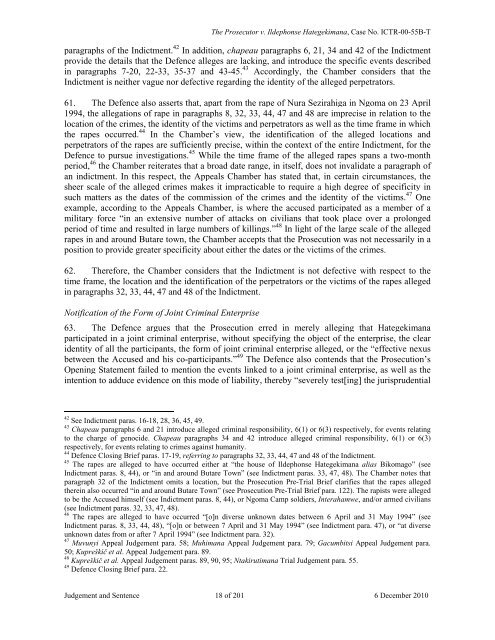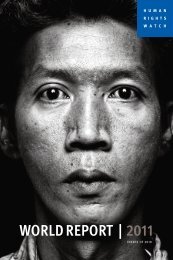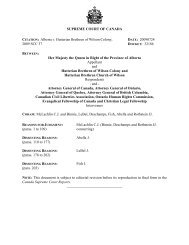Hategekimana - JUDGEMENT & SENTENCE - Refworld
Hategekimana - JUDGEMENT & SENTENCE - Refworld
Hategekimana - JUDGEMENT & SENTENCE - Refworld
Create successful ePaper yourself
Turn your PDF publications into a flip-book with our unique Google optimized e-Paper software.
The Prosecutor v. Ildephonse <strong>Hategekimana</strong>, Case No. ICTR-00-55B-T<br />
paragraphs of the Indictment. 42 In addition, chapeau paragraphs 6, 21, 34 and 42 of the Indictment<br />
provide the details that the Defence alleges are lacking, and introduce the specific events described<br />
in paragraphs 7-20, 22-33, 35-37 and 43-45. 43 Accordingly, the Chamber considers that the<br />
Indictment is neither vague nor defective regarding the identity of the alleged perpetrators.<br />
61. The Defence also asserts that, apart from the rape of Nura Sezirahiga in Ngoma on 23 April<br />
1994, the allegations of rape in paragraphs 8, 32, 33, 44, 47 and 48 are imprecise in relation to the<br />
location of the crimes, the identity of the victims and perpetrators as well as the time frame in which<br />
the rapes occurred. 44 In the Chamber’s view, the identification of the alleged locations and<br />
perpetrators of the rapes are sufficiently precise, within the context of the entire Indictment, for the<br />
Defence to pursue investigations. 45 While the time frame of the alleged rapes spans a two-month<br />
period, 46 the Chamber reiterates that a broad date range, in itself, does not invalidate a paragraph of<br />
an indictment. In this respect, the Appeals Chamber has stated that, in certain circumstances, the<br />
sheer scale of the alleged crimes makes it impracticable to require a high degree of specificity in<br />
such matters as the dates of the commission of the crimes and the identity of the victims. 47 One<br />
example, according to the Appeals Chamber, is where the accused participated as a member of a<br />
military force “in an extensive number of attacks on civilians that took place over a prolonged<br />
period of time and resulted in large numbers of killings.” 48 In light of the large scale of the alleged<br />
rapes in and around Butare town, the Chamber accepts that the Prosecution was not necessarily in a<br />
position to provide greater specificity about either the dates or the victims of the crimes.<br />
62. Therefore, the Chamber considers that the Indictment is not defective with respect to the<br />
time frame, the location and the identification of the perpetrators or the victims of the rapes alleged<br />
in paragraphs 32, 33, 44, 47 and 48 of the Indictment.<br />
Notification of the Form of Joint Criminal Enterprise<br />
63. The Defence argues that the Prosecution erred in merely alleging that <strong>Hategekimana</strong><br />
participated in a joint criminal enterprise, without specifying the object of the enterprise, the clear<br />
identity of all the participants, the form of joint criminal enterprise alleged, or the “effective nexus<br />
between the Accused and his co-participants.” 49 The Defence also contends that the Prosecution’s<br />
Opening Statement failed to mention the events linked to a joint criminal enterprise, as well as the<br />
intention to adduce evidence on this mode of liability, thereby “severely test[ing] the jurisprudential<br />
42 See Indictment paras. 16-18, 28, 36, 45, 49.<br />
43 Chapeau paragraphs 6 and 21 introduce alleged criminal responsibility, 6(1) or 6(3) respectively, for events relating<br />
to the charge of genocide. Chapeau paragraphs 34 and 42 introduce alleged criminal responsibility, 6(1) or 6(3)<br />
respectively, for events relating to crimes against humanity.<br />
44 Defence Closing Brief paras. 17-19, referring to paragraphs 32, 33, 44, 47 and 48 of the Indictment.<br />
45 The rapes are alleged to have occurred either at “the house of Ildephonse <strong>Hategekimana</strong> alias Bikomago” (see<br />
Indictment paras. 8, 44), or “in and around Butare Town” (see Indictment paras. 33, 47, 48). The Chamber notes that<br />
paragraph 32 of the Indictment omits a location, but the Prosecution Pre-Trial Brief clarifies that the rapes alleged<br />
therein also occurred “in and around Butare Town” (see Prosecution Pre-Trial Brief para. 122). The rapists were alleged<br />
to be the Accused himself (see Indictment paras. 8, 44), or Ngoma Camp soldiers, Interahamwe, and/or armed civilians<br />
(see Indictment paras. 32, 33, 47, 48).<br />
46 The rapes are alleged to have occurred “[o]n diverse unknown dates between 6 April and 31 May 1994” (see<br />
Indictment paras. 8, 33, 44, 48), “[o]n or between 7 April and 31 May 1994” (see Indictment para. 47), or “at diverse<br />
unknown dates from or after 7 April 1994” (see Indictment para. 32).<br />
47 Muvunyi Appeal Judgement para. 58; Muhimana Appeal Judgement para. 79; Gacumbitsi Appeal Judgement para.<br />
50; Kupreškič et al. Appeal Judgement para. 89.<br />
48 Kupreškič et al. Appeal Judgement paras. 89, 90, 95; Ntakirutimana Trial Judgement para. 55.<br />
49 Defence Closing Brief para. 22.<br />
Judgement and Sentence 18 of 201 6 December 2010

















